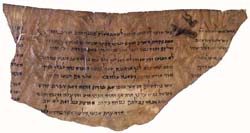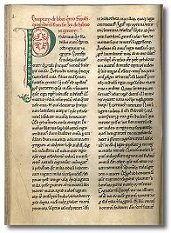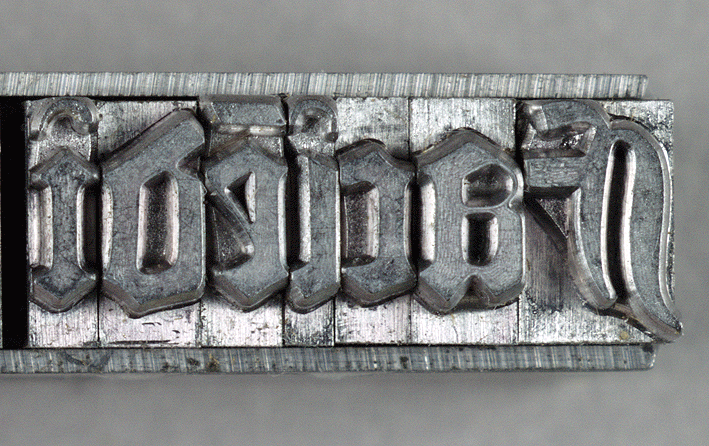|
| |
Major Acquisition
Now that you've got the hang of it,
here's the next prize:
The
Judeo-Christian library
#4
The Dead Sea Scrolls
Isaiah Pesher
A Pesher is a kind of commentary on the Bible that was common in the community that
wrote the Dead Sea Scrolls. This kind of commentary is not an attempt to explain what the
Bible meant when it was originally written, but rather what it means in the day and age of
the commentator, particularly for his own community. In the Isaiah Pesher, or commentary
on the book of Isaiah, a verse or verses from Isaiah are quoted. Then the commentary
begins, often introduced by the word "pesher," or "the interpretation of
the word..." If we were to write a commentary in this way today we might quote a
bible verse and then say, "and the meaning of the verse is..." and go on to show
the significance of the verse for our own church, synagogue, or society.
 |
| Click the image to view an enhanced version. 
|
This particular manuscript quotes several verses from Isaiah 5 concerning punishment or
destruction, and applies them to the "arrogant men" who are in Jerusalem. We
know from other scrolls at Qumran that the people who wrote many of the scrolls had
serious conflicts and disagreements with the religious leaders in Jerusalem over the
proper way to conduct worship in the Temple. Most scholars think that the community of the
Dead Sea Scrolls was led by a group of priests who thought that the Jerusalem priests were
corrupt. The group at Qumran therefore started their own community in which they tried to
live pure and righteous lives, away from th corrupting influence of Jerusalem. |
#5
HISTORY OF THE FIRST CRUSADE
by FULCHER OF CHARTRES, 1095-1106
Also included in text:
- GESTA TREVERORUM, THE HISTORY OF TRIER FROM CA. 2000 BC TO 1032 AD
- FRECULPHUS: CLASSICAL CHRONICLE, EXCERPTS: PTOLEMAIOS PHILADELPHUS, HERODUS ANTIPAS,
TROJAN WAR, FOUNDATION OF ROME, HISTORIES OF EPHESOS, BABYLON, CARTHAGE, CORINTH, NUMIDIA
AND JERUSALEM
- WILLIAM OF MALMESBURY: DE REBUS GESTIS REGUM ANGLORUM. THE HISTORY OF THE KINGS OF
ENGLAND FROM THE ANGLO-SAXONS TO HENRY 1
 MS in Latin on vellum, Cambrai, Belgium, ca.
1160-70, , 31-34 lines in a very handsome late Romanesque book script of good quality by 4
scribes. Binding: France, ca. 1700, calf gilt over pasteboards, sewn on 5 cords,
red mottled edges. MS in Latin on vellum, Cambrai, Belgium, ca.
1160-70, , 31-34 lines in a very handsome late Romanesque book script of good quality by 4
scribes. Binding: France, ca. 1700, calf gilt over pasteboards, sewn on 5 cords,
red mottled edges.
Provenance(Owners) : 1. Premonstratensian Abbey of Bonne-Esperance, Cambrai,
Belgium (ca. 1170-ca. 1800); 2. Longman cat. (1816):6347; 3. Thomas Thorpe cat.
III(1823):16359; 4. Sir Thomas Phillipps, Cheltenham, Ph 237, (1822-1872); 5. Katharine,
John, Thomas & Alan Fenwick, Cheltenham, (1872-1946); 6. Robinson Bros., London
(1946-1978); 7. H.P. Kraus cat. 153(1979):19; 8. Sam Fogg cat. 14(1991):2.
Commentary: An eyewitness account of the first crusade in a MS made during the
2nd crusade. |
#6
The Gutenberg Bible
First book printed using moveable type |
|
|
The Printing of the Bible
Gutenberg experimented with printing single sheets of paper and even small books, such
as a simple textbook of Latin grammar, before beginning his work on the Bible around 1450.
In order to carry out these projects, he would have had to invent a printing press and
develop a method of casting individual pieces of metal type. Gutenberg's press was made
out of wood and could have been modeled on the winepresses used in the Rhineland vineyards
or on the papermaker's press. His type was made of a metal alloy which would melt at a
fairly low temperature but which could also stand up to being squeezed in a press. It was
long thought that Gutenberg had originated the punch-matrix-mold system of typecasting
used by typemakers for hundreds of years, but very recent research has cast doubt on this
theory. Quite possibly Gutenberg used a cruder system, casting his metal types not in
re-usable molds, but in sand or some other unstable medium. In any event, the process must
have been a long and laborious one, since nearly 300 different pieces of type are used in
the Bible.
The handmade paper used by Gutenberg was of fine quality and was imported from Italy.
Each sheet contains a watermark, which may be seen when the paper is held up to the light,
left by the papermold. The two watermark designs are the grape cluster and the bull's
head. Some copies of the Bible were printed on vellum (scraped calfskin). Gutenberg's
oil-based ink, made sufficiently thick enough to cling to the type, is exceptionally black
because of its high metal composition.
The number of presses in Gutenberg's shop is unknown, but the number of pages he needed
to print suggests that more than one press must have been in use. A skilled typesetter
selected the individual pieces of type for each line of the text and set them in a frame
(the forme), which was placed on the bed of the press and then inked with
horsehair-stuffed balls. A sheet of paper was slightly moistened before being placed over
the forme, and then a stout pull by the pressman completed the printing process.
No one knows exactly how many copies of the Bible were printed, but the best guess is
that around 180 -- 145 on paper and the rest on the more luxurious and expensive vellum --
were produced. A contemporary account by a visitor to Mainz indicates that the book was
nearly ready in October 1454 and available for sale by March 1455. Although the cost of
the book is not known, it would have been far too expensive even for wealthy individuals,
and so most copies were likely purchased by churches and monasteries.
A modern recreation of Gutenberg's type:

|
|
| The Question: Rorty steps back to give a sweeping summary of the history of
philosophy: Once upon a time we felt we had
to worship something that lay beyond the visible world.
Beginning in the 17th century, we tried to substitute a love of
truth for a love of God by treating the world of science as a quasi-divinity. At the end of the 18th century we tried
substituting a love of ourselves, led by the Romantic poets, to put science back in its
place. Our deep spiritual, poetic nature was
also seen as a quasi-divinity. Through
Nietzsche, Freud and Davidson, we took the next step towards trying not to worship
anything; nothing is divine and our language, conscience and community are seen as a
product of time and chance. (21-22).
Nietzsche has urged us to drop the search for truth; truth is a
“mobile army of metaphors” and we should forget trying to represent reality by
means of language. There is just no single
context for all human lives. Better to pursue
self-creation. For Nietzsche, “failure”
is accepting someone else’s description of oneself.
In acquiring knowledge of oneself through tracking down one’s specific
contingencies, like the “strong poet”, we can use words as they have never been
used before, invent our own vocabularies and therefore write our own stories. In that way we can dominate our contingencies and
“will ourselves to power” by getting control of our lives. (28).
In ancient Greek literature, and
especially in Sophocles, characters often saw themselves as victims of Fate or Chance.
Stories often portrayed the protagonist, in most cases a good man, besieged by
problems beyond his control. Literature at this time allowed people to
experience catharsis but it did not teach them how to cope with tragedy. We still
acknowledge tragedy may happen in an individual's life, but what do you think Rorty and
Nietzsche mean by dropping the search for truth? |
|